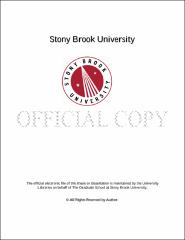| dc.identifier.uri | http://hdl.handle.net/11401/76692 | |
| dc.description.sponsorship | This work is sponsored by the Stony Brook University Graduate School in compliance with the requirements for completion of degree. | en_US |
| dc.format | Monograph | |
| dc.format.medium | Electronic Resource | en_US |
| dc.language.iso | en_US | |
| dc.publisher | The Graduate School, Stony Brook University: Stony Brook, NY. | |
| dc.type | Dissertation | |
| dcterms.abstract | Systems of mesoscopic Josephson junctions are at present among the leading candidates for development of practical qubits for quantum information devices. Although different qubit structures have been realized with Josephson junctions, their common feature is the design that is optimized to overcome the problem of decoherence by the low-frequency noise that exists in all solid-state structures. In the presented dissertation research, we propose and study an alternative approach of direct suppression of noise by a feedback loop based on the low-frequency quantum measurements. The minimal noise induced in the qubit by such a feedback loop is calculated under the conditions of continuous quantum-limited measurements. Another obstacle facing the quantum Josephson junction circuits is the information transfer between the circuit elements. Here we study the quantum dynamics of dual-rail arrays of nSQUIDs characterized by a negative inductance between its arms, which hold promise for quantum information transfer. The scaling and decoherence properties of these arrays are analyzed. Information transfer along nSQUID arrays can also be used to implement adiabatic quantum computation (AQC), an alternative to the gate-model approach to quantum computation that is expected to be more stable against the decoherence. Here we suggest fidelity of the ground state as the quantitative measure of the ultimate effect of decoherence on AQC. We show that decoherence-induced deformation of the ground state of an AQC algorithm is characterized by the same noise correlators as those that determine the decoherence time in the gate-model approach. Results for fidelity of a 16-qubit array at finite temperatures are obtained numerically. | |
| dcterms.available | 2017-09-20T16:51:00Z | |
| dcterms.contributor | Averin, Dmitri V | en_US |
| dcterms.contributor | Verbaarschot, Jacobus | en_US |
| dcterms.contributor | Du, Xu | en_US |
| dcterms.contributor | Jia, Jiangyong | en_US |
| dcterms.contributor | Luryi, Serge. | en_US |
| dcterms.creator | Deng, Qiang | |
| dcterms.dateAccepted | 2017-09-20T16:51:00Z | |
| dcterms.dateSubmitted | 2017-09-20T16:51:00Z | |
| dcterms.description | Department of Physics. | en_US |
| dcterms.extent | 117 pg. | en_US |
| dcterms.format | Application/PDF | en_US |
| dcterms.format | Monograph | |
| dcterms.identifier | http://hdl.handle.net/11401/76692 | |
| dcterms.issued | 2013-12-01 | |
| dcterms.language | en_US | |
| dcterms.provenance | Made available in DSpace on 2017-09-20T16:51:00Z (GMT). No. of bitstreams: 1
Deng_grad.sunysb_0771E_11461.pdf: 2091524 bytes, checksum: bd4f781e8302eb2c72fbc8e91cc21959 (MD5)
Previous issue date: 1 | en |
| dcterms.publisher | The Graduate School, Stony Brook University: Stony Brook, NY. | |
| dcterms.subject | Adiabatic Quantum Computation, Fidelity, Low-Frequency Noise, nSQUID, Quantum Computation, Superconducting qubits | |
| dcterms.subject | Quantum physics | |
| dcterms.title | Quantum Computation and Quantum Measurements with Mesoscopic Superconducting Structures | |
| dcterms.type | Dissertation | |

